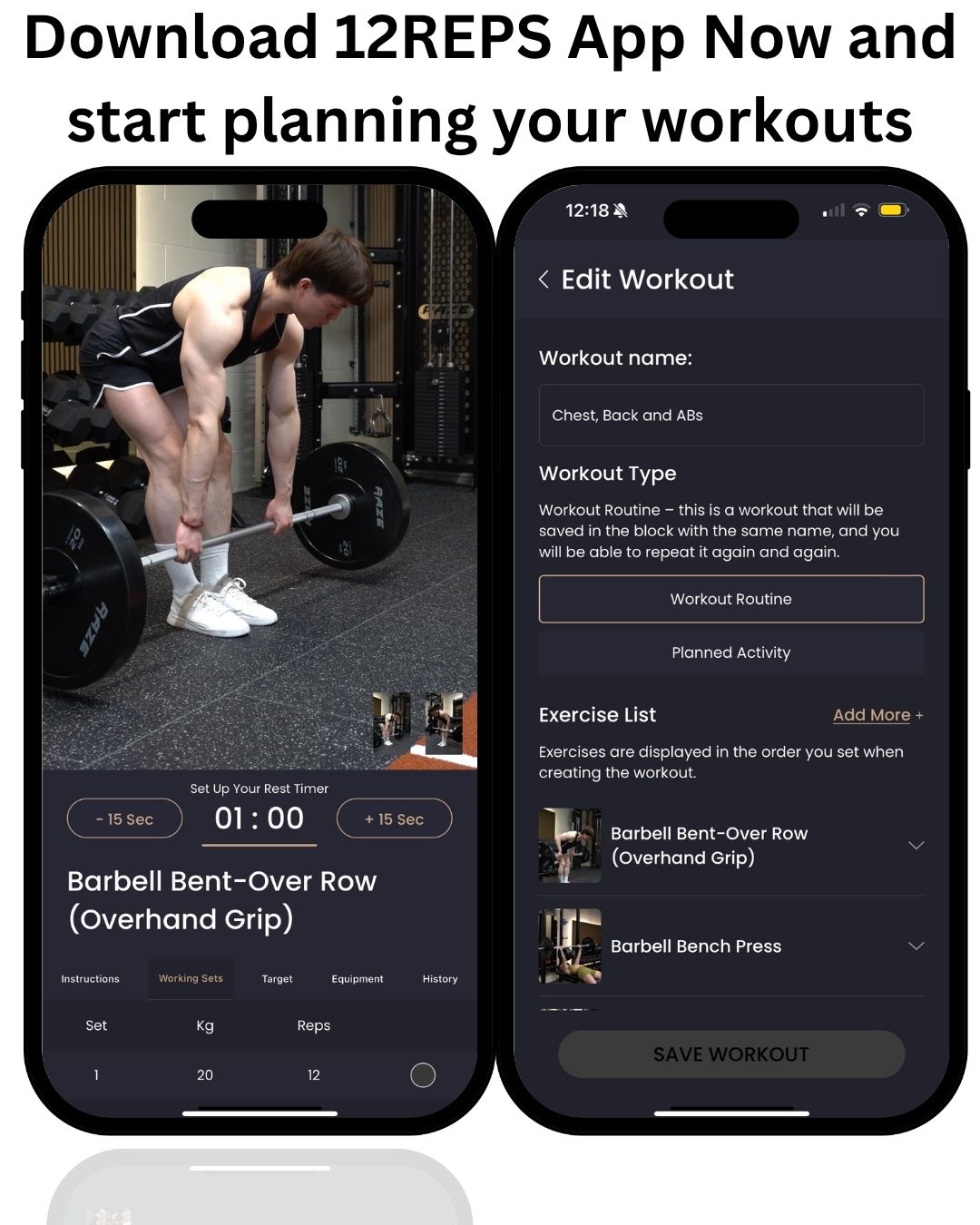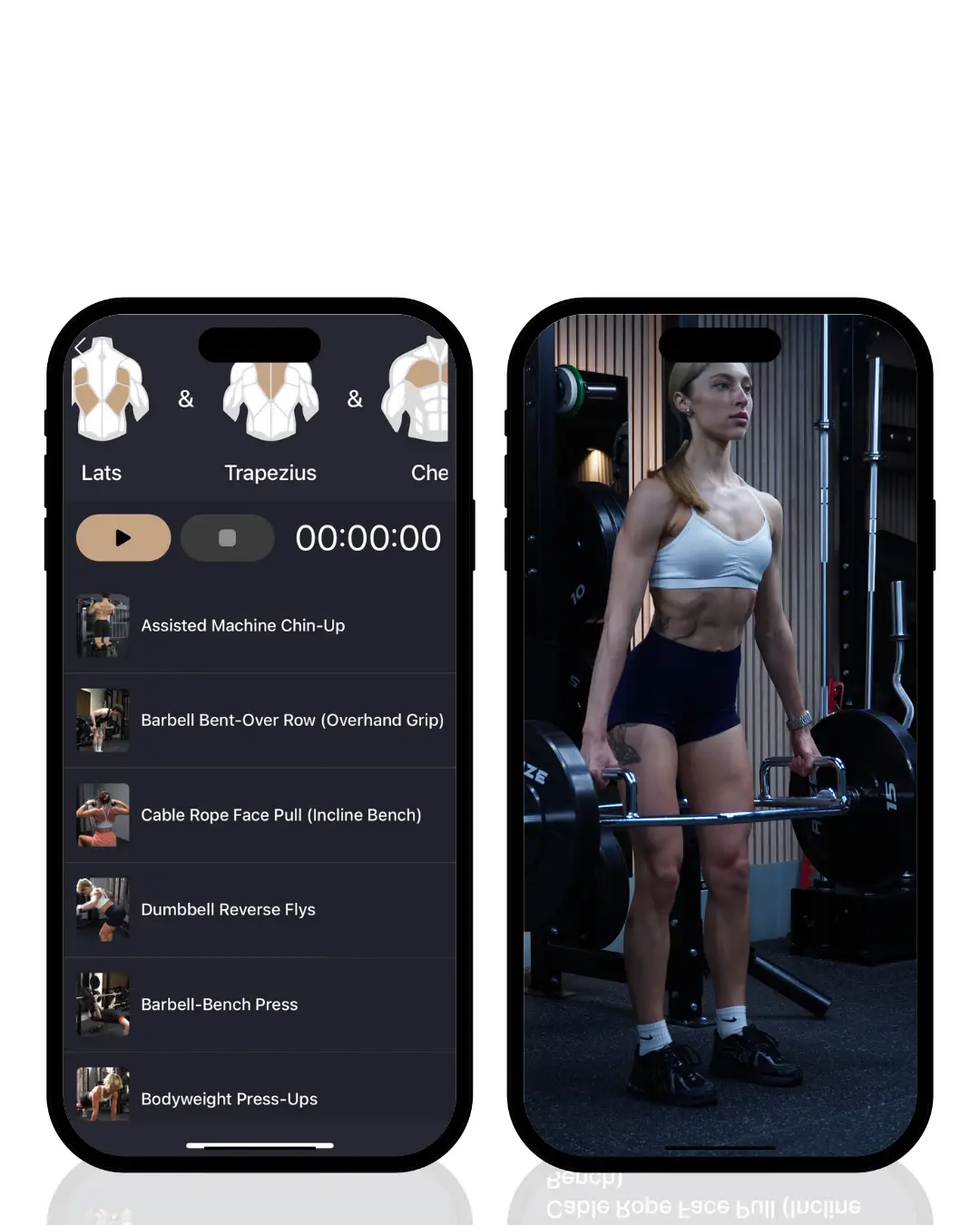By Will Duru, BSc (Hons) Sport and Exercise Science, Award-winning Personal Trainer with over 10 years of experience in strength training and optimising recovery.
The questions I hear
Should I do cardio before or after weights
Will cardio kill my gains
Can I build muscle and improve cardio at the same time
The truth
Most goals benefit from both strength and cardio.
The win is in how you combine them.
Optimise the mix, don’t avoid it.
What I see in the gym
A decade of coaching says this clearly.
The best results come from smart integration.
Not from choosing one style only.
What the science says
Concurrent training has evolved.
The “interference effect” is real but manageable.
With the right plan you can maximise both strength and endurance.
Why 12-rep training helps
Moderate intensity with solid metabolic demand.
A strong base for adding cardio without losing progress.
Build muscle, gain strength, and raise fitness together.
How 12reps fits
The app removes guesswork.
Complete programs that blend lifting and cardio the right way.
Whether you are intermediate or advanced, you get the structure to unlock new levels.

The Science of Concurrent Training
What it is
In the 1980s, research showed cardio plus strength could blunt strength gains.
This is the “interference effect.”
Modern studies say it is manageable if you plan well.
What drives interference
High volume, steady, moderate-intensity cardio causes the most conflict.
Think long, continuous runs or rides at a steady pace.
Short, high-intensity intervals cause far less conflict.
Some interval work can even support power and work capacity.
Why it happens (simple)
Strength work pushes mTOR. That is your muscle-building pathway.
Endurance pushes AMPK. That builds aerobic capacity.
Very long, moderate cardio can keep AMPK high and dampen mTOR.
Short, sharp cardio spikes AMPK less, so strength signals stay strong.
How to program so you keep getting stronger
Session order
If done on the same day, lift first. Cardio after.
Better yet, separate by at least 6 hours.
Weekly mix
Use intervals for most cardio.
Keep steady state short when close to heavy lower-body days.
Volume limits
Start with 60 to 120 minutes of total cardio per week.
Keep most work under 30 minutes per session when you are pushing strength.
Mode matters
Cycling, rowing, sled work are kinder to legs than long runs.
Hill sprints beat flat, hard road runs. Less pounding.
Intervals that play nice
6 to 12 rounds of 20 to 60 seconds hard.
Rest 60 to 120 seconds easy.
Stop while reps are still fast and crisp.
Steady state rules
If you need it, keep it easy and brief.
20 to 30 minutes on a bike or incline walk.
Place it away from heavy squat or deadlift days.
Adjust lifting
When cardio volume rises, trim a little accessory work.
Keep the big lifts. Keep intensity.
Use deload weeks every 4 to 8 weeks.
Fuel and recovery
Eat carbs around strength sessions.
30 to 60 g carbs and 20 to 30 g protein in the 2 hours pre.
Refill carbs after long or hard cardio.
Sleep 7 to 9 hours. Hydrate. Add electrolytes on sweaty days.
Simple 3-day strength with 2-day cardio template
Mon: Lower strength
Squat 5×3 to 5×5, hinge, lunges, calves
Tue: Bike HIIT 8×40s hard, 80s easy. Core 10 minutes
Wed: Upper strength
Bench or press 5×3 to 5×5, row, pulldown, arms
Deadlift 3×3 to 5×3, front squat 3×5, posterior chain
Fri: Lower strength
Sat: Hill sprints 8×10 to 15 seconds. Full rest walks down
Thu/Sun: Optional 20 to 30 min easy cycle or walk
How 12REPS helps
Plans intervals that pair with your heavy days.
Schedules strength first, cardio later, with smart spacing.
Flags when your total cardio volume risks strength.
Gives clear food timing prompts before and after key sessions.
You can lift and do cardio. You just need the right order, volume, and mode. Keep strength the priority, keep intervals sharp, fuel well, and you will progress.

Core idea
Timing shapes results.
Strength and cardio send signals that last for hours.
Line them up so they help, not clash.
What to avoid
Cardio before lifting
You start the lift already tired.
Loads drop. Volume drops.
Glycogen is lower. Your sets suffer.
AMPK can blunt the mTOR signal from strength work.
The muscle-building response can drop, especially with longer, moderate cardio.
Long, steady cardio right after lifting
What to do instead
Lift first, then short HIIT
Keep intervals brief and sharp.
Minimal interference, with some upside for work capacity.
Separate sessions when you can
Leave 6–8 hours between strength and cardio.
Each signal gets time to run its course.
Pick smart cardio modes
Short intervals on bike, rower, hills.
Limit pounding runs near heavy lower-body days.
Keep total cardio time sensible when strength is the priority.
Add minutes slowly as conditioning improves.
Match volume to your goal
Individual responses
People adapt differently.
Beginners do well with both at once. Plenty of room to grow.
Experienced lifters need tighter planning.
Endurance backgrounds may feel more interference.
Strength backgrounds often handle added cardio better.
Genetics, fiber type, recovery, and current fitness all matter.
Adjusts plans to your history and recovery.
Tunes volume, intensity, and spacing based on your feedback.
Keeps strength the anchor while you build fitness.
How 12reps helps
Why combine them
Cardio fitness can improve more with strength on board.
Body composition changes beat single-modality programs [3].
Metabolic health markers improve more when you train both.
Function in real life needs strength and endurance together.
Psychology matters. Variety keeps you engaged and consistent.
Simple rules to remember
Lift first when sessions are back to back.
If possible, split day: morning lift, evening intervals.
Keep post-lift cardio short, high-quality, and crisp.
Place longer easy cardio on separate days.
Fuel with carbs and protein around strength.
Sleep, hydrate, and track how you feel.
Train with intent. Time it right. You will build strength, keep muscle, and raise your fitness without tripping over interference.

Optimising Concurrent Training with 12-Rep Protocols
The 12-rep training methodology provides an ideal foundation for concurrent training programs. The moderate intensity and significant metabolic demands of 12-rep protocols create adaptations that complement rather than compete with cardiovascular training.
Unlike heavy strength training (1-5 reps) or high-volume bodybuilding protocols (15+ reps), 12-rep training occupies a sweet spot that develops strength, muscle mass, and metabolic conditioning simultaneously. This makes it naturally compatible with cardiovascular training additions.
The metabolic stress created by 12-rep training enhances the body’s ability to buffer lactate and tolerate the metabolic demands of high-intensity cardiovascular work. This creates a synergistic effect where strength training actually improves cardiovascular exercise capacity.
Recovery demands from 12-rep training are moderate compared to maximal strength protocols, leaving more capacity for cardiovascular training additions. The balanced stress allows for higher total training volumes without overwhelming recovery systems.
The 12reps app optimises the combination of strength and cardio training based on the latest exercise science, ensuring that your 12-rep strength sessions integrate seamlessly with cardiovascular work for maximum results. This evidence-based approach eliminates the guesswork from concurrent training while maximising the benefits of both training modalities.
Cardio Types and Their Integration with 12-Rep Training
Big idea
Use both. Pick the right type for the goal and the day.
Keep strength first. Add cardio that supports it.
HIIT in a nutshell
Work hard, then recover, repeat.
Work bouts at 85–95% max heart rate.
Recover at 50–65% max heart rate.
Matches 12-rep lifting energy demands.
Minimal interference with strength when kept short.
Why lifters like HIIT
Trains the same glycolytic system as your sets of 8–12.
Improves lactate buffering and tolerance to burn.
Carries over to hard sets and short rest periods.
Go-to HIIT options
Bike sprints: 8–12 rounds of 20–40 seconds hard, 60–120 seconds easy.
Row sprints: 10 rounds of 250 m fast, 75–90 seconds easy.
Hills: 8–10 sprints of 10–15 seconds, walk back recover.
When to place HIIT
After lifting on the same day. Keep it brief.
Or separate by 6–8 hours if you can.
Cap total HIIT time at 10–20 minutes of hard work.
Steady-state in a nutshell
One pace for longer.
60–75% max heart rate.
Great for aerobic base and fat use.
Higher chance of strength interference if volume is high and close to leg days.
When to use steady-state
On separate days from heavy lower-body sessions.
Keep sessions modest during strength blocks.
Simple steady-state options
25–40 minutes: incline walk, easy cycle, light jog.
Talk test passes. You can speak in full sentences.
LISS as the recovery tool
Low-intensity steady state at 60–70% max heart rate.
Low AMPK activation. Strength signal keeps rolling.
Boosts capillary density and mitochondrial function.
Easiest way to add weekly calorie burn without beating up legs.
How to slot LISS
20–30 minutes on rest days or the morning after heavy lifting.
Bike, brisk walk, easy row.
Keep it relaxing and repeatable.
Weekly templates
Strength-first (3 lift days, 2 cardio days)
Mon: Lower strength + 10–12 min HIIT bike
Wed: Upper strength + optional 20–30 min LISS
Fri: Lower strength
Sat: HIIT hills 12–15 min
Sun: 20–30 min LISS or steps goal
Fat-loss with strength hold
Mon: Full-body strength + 8–10 min HIIT
Tue: 30 min LISS
Thu: Full-body strength + 8–10 min HIIT
Sat: 30 min LISS
Daily steps high
Engine build, strength maintained
Mon: Lower strength
Tue: 30–40 min steady-state (separate day)
Thu: Upper strength + 8 min HIIT
Sat: 30–35 min steady-state
Keep lower-body accessories a bit lighter these weeks
Simple rules
Lift before cardio if same day.
Keep HIIT short and sharp.
Put longer steady-state on separate days.
Choose bike or rower when legs are sore.
Add minutes slowly. Track performance in the big lifts.
Fuel and recovery
Carbs plus protein before lifting.
Refill carbs after HIIT or longer cardio.
Sleep well. Hydrate. Keep electrolytes on hot days.
How 12reps helps
Auto-fits HIIT after your lift days.
Schedules LISS on recovery days.
Flags when cardio volume starts to drag on strength.
Adjusts based on your logs and weekly feedback.
Use HIIT for carryover to your sets. Use LISS to recover and keep volume up. Keep steady-state smart and separate. That’s how you build muscle, hold strength, and raise fitness together.

HIIT Protocols That Work With 12-Rep Strength
Core idea
HIIT fits 12-rep lifting because both use work and rest.
Match interval length to the goal.
Keep strength first, then add the right HIIT.
Intensity targets
Work sets: 85 to 95 percent max heart rate.
Recoveries: 50 to 65 percent max heart rate.
Start with 1 to 2 HIIT days per week. Cap hard work at 10 to 20 minutes.
Short-interval HIIT (15 to 30 seconds)
Goal: power and anaerobic capacity.
Low metabolic drag, fast recovery between sets in the gym improves.
Examples
Bike: 10 to 12 rounds of 20 seconds hard, 80 to 100 seconds easy.
Row: 12 rounds of 15 seconds hard, 60 seconds easy.
Hills: 8 to 10 sprints of 10 to 15 seconds, walk back recovery.
Medium-interval HIIT (1 to 2 minutes)
Goal: glycolytic system, best carryover to 12-rep sets.
Improves lactate tolerance and buffering.
Examples
Bike: 8 rounds of 60 to 90 seconds hard, 90 to 150 seconds easy.
Row: 6 to 8 rounds of 2 minutes hard, 2 to 3 minutes easy.
Assault bike or ski erg: 8 rounds of 60 seconds hard, 2 minutes easy.
Long-interval HIIT (3 to 4 minutes)
Goal: aerobic power with minimal interference.
Bridges anaerobic and aerobic work without long steady stress.
Examples
4 rounds of 4 minutes hard, 3 minutes easy.
5 rounds of 3 minutes hard, 2 to 3 minutes easy.
Modality choice
Cycling
Lowest interference with strength, especially upper body.
Less eccentric stress, kinder to legs.
Best default for most lifters.
Running
Powerful tool, but impact adds leg fatigue.
Keep total volume modest near squat or deadlift days.
Use hills or soft surfaces when possible.
Rowing
Full-body drive, supports posterior chain.
Great mix with pulling work.
Watch grip fatigue if you row before heavy pulls.
Placement with lifting
Same day: lift first, HIIT after, keep HIIT brief.
Split day: separate by 6 to 8 hours when you can.
Separate days: put longer intervals or steady work here.
Weekly templates
Strength focus (3 lifts, 2 HIIT)
Mon: Lower strength, then 10 minutes short HIIT
Wed: Upper strength
Fri: Lower strength
Sat: Medium-interval HIIT 12 to 16 minutes
Sun: Optional 20 to 30 minutes easy LISS
Cutting while holding strength
Mon: Full-body strength, 8 to 10 minutes short HIIT
Thu: Full-body strength, 8 to 10 minutes short HIIT
Sat: 20 to 30 minutes LISS
Sport-specific cardio
Combat sports
Rounds on the heavy bag or pads.
2 to 3 minute work, 1 minute rest.
Matches fight pacing and keeps skills sharp.
Team sports
Small-sided games or position drills.
Natural intervals, high carryover to match demands.
Endurance athletes
Use shorter, harder sessions for skill and economy.
Keep high-volume steady work away from heavy leg days.
Progression rules
Add rounds slowly, or extend work by 10 to 15 seconds.
Keep quality high. When power drops, stop the set.
Track HR recovery between bouts. Faster drop equals better fitness.
How 12reps helps
Schedules HIIT after your lifts or on separate days.
Suggests the best modality based on your week.
Flags conflict with heavy leg sessions.
Adjusts interval length and total rounds from your training logs.
Pick the interval type that matches your goal, place it smartly, and keep it short and sharp. That is how you get fitter and stay strong.

Sample Combined Training Programs
4-Day Strength + 2-Day Cardio Program
This program separates strength and cardio training for optimal recovery and performance. You train strength four days per week using 12-rep protocols, with two dedicated cardio sessions.
Monday: Upper Body Strength
– Pull-ups: 3 sets x 12 reps
– Bench Press: 3 sets x 12 reps
– Bent-over Rows: 3 sets x 12 reps
– Overhead Press: 3 sets x 12 reps
– Bicep Curls: 2 sets x 12 reps
– Tricep Extensions: 2 sets x 12 reps
Tuesday: HIIT Cardio
– 5-minute warm-up
– 8 rounds: 30 seconds high intensity, 90 seconds recovery
– 5-minute cool-down
– Total time: 25 minutes
Wednesday: Lower Body Strength
– Squats: 4 sets x 12 reps
– Deadlifts: 3 sets x 12 reps
– Lunges: 3 sets x 12 per leg
– Calf Raises: 3 sets x 15 reps
– Plank: 2 sets x 45 seconds
Thursday: Upper Body Strength
– Chin-ups: 3 sets x 12 reps
– Incline Press: 3 sets x 12 reps
– Cable Rows: 3 sets x 12 reps
– Lateral Raises: 3 sets x 12 reps
– Face Pulls: 2 sets x 15 reps
Friday: Lower Body Strength
– Romanian Deadlifts: 3 sets x 12 reps
– Bulgarian Split Squats: 3 sets x 12 per leg
– Hip Thrusts: 3 sets x 12 reps
– Walking Lunges: 2 sets x 20 total
– Russian Twists: 2 sets x 20 total
Saturday: Steady-State Cardio
– 30-45 minutes at moderate intensity
– Heart rate 65-75% maximum
– Choose cycling, walking, or swimming
Sunday: Rest or light activity
This program provides 12 sets per muscle group weekly while maintaining clear separation between strength and cardio training. The 12reps app automates this programming with personalised load progression and recovery monitoring.
Daily Combined Training Approach
This program combines strength and cardio in every session. Each workout includes 12-rep strength training followed by brief cardio intervals.
Monday: Full Body + HIIT
– Squats: 3 sets x 12 reps
– Push-ups: 3 sets x 12 reps
– Bent-over Rows: 3 sets x 12 reps
– Plank: 2 sets x 30 seconds
– HIIT Finisher: 10 minutes (20 seconds work, 40 seconds rest)
Tuesday: Upper Focus + Cardio
– Pull-ups: 3 sets x 12 reps
– Bench Press: 3 sets x 12 reps
– Overhead Press: 3 sets x 12 reps
– Bicep Curls: 2 sets x 12 reps
– Steady-state cardio: 15 minutes moderate intensity
Wednesday: Lower Focus + HIIT
– Deadlifts: 3 sets x 12 reps
– Lunges: 3 sets x 12 per leg
– Calf Raises: 3 sets x 15 reps
– Glute Bridges: 2 sets x 15 reps
– HIIT Finisher: 8 minutes (30 seconds work, 90 seconds rest)
Thursday: Full Body + Cardio
– Goblet Squats: 3 sets x 12 reps
– Incline Push-ups: 3 sets x 12 reps
– Single-arm Rows: 3 sets x 12 per arm
– Step-ups: 2 sets x 12 per leg
– Steady-state cardio: 20 minutes low intensity
Friday: Strength Circuit + HIIT
– Circuit: Squats, Push-ups, Rows, Lunges (3 rounds, 12 reps each)
– Rest 2 minutes between rounds
– HIIT Finisher: 12 minutes (15 seconds work, 45 seconds rest)
Weekend: Active recovery or rest
Each session takes 45-60 minutes total. The combination provides a strong stimulus while improving cardiovascular fitness efficiently.
Seasonal Periodisation Models
Phase 1: Base Building (Weeks 1-8)
Focus on building an aerobic base and a strength foundation.
Strength Training:
– 3 days per week, full body
– 12-15 reps per set
– Moderate intensity, focus on form
Cardio Training:
– 3 days per week
– 70% steady-state, 30% intervals
– Build duration gradually
Phase 2: Intensity Development (Weeks 9-16)
Increase training intensity while maintaining volume.
Strength Training:
– 4 days per week, upper/lower split
– 10-12 reps per set
– Increase loads progressively
Cardio Training:
– 3-4 days per week
– 50% steady-state, 50% intervals
– Shorter, more intense sessions
Phase 3: Peak Performance (Weeks 17-20)
Maximise intensity, reduce volume for peak adaptations.
Strength Training:
– 4 days per week
– 8-12 reps per set
– Focus on compound movements
Cardio Training:
– 3 days per week
– 30% steady-state, 70% high-intensity
– Short, powerful sessions
Phase 4: Recovery (Weeks 21-24)
Active recovery to prepare for next training cycle.
Strength Training:
– 2-3 days per week
– 12-15 reps per set
– Reduced intensity and volume
Cardio Training:
– 2-3 days per week
– Low-intensity activities
– Focus on enjoyment and recovery
Goal-Specific Program Variations
Fat Loss Focus
Emphasise higher training frequency with moderate intensity.
– Strength: 4 days per week, 12-15 reps
– Cardio: 5 days per week, mix of HIIT and steady-state
– Nutrition: Moderate calorie deficit
– Recovery: Prioritise sleep and stress management
Muscle Building Focus
Prioritise strength training with supportive cardio.
– Strength: 4-5 days per week, 8-12 reps
– Cardio: 2-3 days per week, low-intensity only
– Nutrition: Slight calorie surplus
– Recovery: Extra rest days as needed
Athletic Performance Focus
Sport-specific training with supporting fitness work.
– Strength: 3-4 days per week, 6-12 reps
– Cardio: 3-4 days per week, sport-specific patterns
– Skills: Daily practice as appropriate
– Recovery: Active recovery and mobility work
General Fitness Focus
Balanced approach for overall health and fitness.
– Strength: 3 days per week, 10-15 reps
– Cardio: 3 days per week, variety of intensities
– Activities: Include recreational sports and activities
– Recovery: Flexible based on life demands
Progression and Adaptation Strategies
Linear Progression
Add weight when you complete all sets with perfect form.
– Week 1-2: Learn movement patterns
– Week 3-4: Add 2.5-5kg when possible
– Week 5-6: Continue progressive overload
– Week 7-8: Deload with reduced intensity
Volume Progression
Increase training volume before adding intensity.
– Start with 2 sets per exercise
– Add 1 set every 2 weeks
– Maximum 4 sets per exercise
– Reset to 2 sets with heavier weight
Intensity Progression
Gradually increase training intensity over time.
– Week 1-2: 70% effort level
– Week 3-4: 75% effort level
– Week 5-6: 80% effort level
– Week 7-8: 85% effort level, then deload
Frequency Progression
Increase training frequency as adaptation occurs.
– Month 1: 3 days per week
– Month 2: 4 days per week
– Month 3: 5 days per week
– Month 4: Maintain or reduce based on recovery
Cardio Progression
Build cardiovascular fitness systematically.
– Week 1-2: 15-20 minutes per session
– Week 3-4: 20-25 minutes per session
– Week 5-6: 25-30 minutes per session
– Week 7-8: Maintain duration, increase intensity
Program Customisation Guidelines
Beginner Modifications
– Start with 2 sets per exercise
– Use bodyweight or light weights
– Focus on movement quality over intensity
– Include extra rest days as needed
– Progress slowly and consistently
Intermediate Adaptations
– Use full program as written
– Focus on progressive overload
– Add variety in exercise selection
– Monitor recovery carefully
– Adjust based on individual response
Advanced Modifications
– Increase training frequency
– Add advanced exercise variations
– Use periodisation strategies
– Include specialisation phases
– Monitor performance metrics closely
Time-Constrained Options
– Combine exercises into circuits
– Use supersets to save time
– Focus on compound movements
– Reduce rest periods slightly
– Prioritise most important exercises
Equipment-Limited Adaptations
– Use bodyweight alternatives
– Employ resistance bands
– Focus on unilateral exercises
– Increase time under tension
– Use creative loading strategies
The 12reps app provides all these program variations with automatic progression tracking, exercise demonstrations, and personalised modifications based on your equipment, time availability, and fitness level. These proven combined training programs are available in the app, with automatic scheduling and progression management to ensure optimal results from your strength and cardio integration.
Download the 12reps app to see all exercise demos
Conclusion
Combining 12-rep training with cardio training is not just possible, it’s optimal for most fitness goals. The science clearly shows that properly integrated concurrent training produces superior results compared to focusing on just one training type.
The key principles are straightforward. Use HIIT protocols rather than long steady-state cardio to minimise interference. Time your sessions strategically, with strength training first when combining in the same session. Allow adequate recovery between high-intensity sessions. Focus on 12-rep protocols that naturally complement cardiovascular training.
The interference effect that once scared people away from concurrent training is largely a myth when you apply these evidence-based strategies. Modern research shows that smart programming eliminates most interference while maximising the benefits of both training types.
Your body is designed to adapt to multiple training stimuli simultaneously. The 12-rep methodology provides the perfect foundation for this integration, creating metabolic adaptations that enhance both strength and cardiovascular performance.
The programs outlined in this article represent years of research and practical application. They work because they respect the science while remaining practical for real-world implementation. Whether you choose separate-day programming or combined sessions, the principles remain the same.
Recovery and progression monitoring become even more important with concurrent training. Listen to your body, track your performance, and adjust intensity based on your response. The goal is sustainable progress, not short-term gains that lead to burnout.
The 12reps app takes all the guesswork out of concurrent training. Every program is scientifically designed to optimise the combination of strength and cardio training. The app automatically adjusts your training based on your progress, available time, and recovery status.
You get access to all the programs mentioned in this article, plus dozens more variations. The intelligent scheduling system ensures perfect timing between strength and cardio sessions. Exercise demonstrations guarantee proper form. Progress tracking shows exactly how your fitness is improving.
Most importantly, the 12reps app adapts to your life. Whether you have 30 minutes or 90 minutes, whether you’re training at home or in a gym, the app provides the optimal combination of strength and cardio training tailored to your needs.
Stop wasting time with outdated approaches that force you to choose between strength and cardio. The science is clear, the methods are proven, and the results speak for themselves.
Ready for the ultimate combination of strength and cardio training? The 12reps app provides complete programs that optimise for maximum results. Download today and experience the power of properly integrated concurrent training.
Your strongest, fittest self is waiting. The 12Reps app will get you there faster than you ever thought possible.

References
[1] Methenitis, S. (2018). A Brief Review on Concurrent Training: From Laboratory to the Field. *Sports*, 6(4), 127. https://pmc.ncbi.nlm.nih.gov/articles/PMC6315763/
[2] Wilson, J. M., Marin, P. J., Rhea, M. R., Wilson, S. M., Loenneke, J. P., & Anderson, J. C. (2012). Concurrent training: a meta-analysis examining interference of aerobic and resistance exercises. *Journal of Strength and Conditioning Research*, 26(8), 2293-2307. https://journals.lww.com/nsca-jscr/fulltext/2012/08000/concurrent_training__a_meta_analysis_examining.35.aspx
[3] Schroeder, E. C., Franke, W. D., Sharp, R. L., & Lee, D. C. (2019). Comparative effectiveness of aerobic, resistance, and combined training on cardiovascular disease risk factors: A randomized controlled trial. *PLOS ONE*, 14(1), e0210292. https://journals.plos.org/plosone/article?id=10.1371/journal.pone.0210292
[4] Coffey, V. G., & Hawley, J. A. (2017). Concurrent exercise training: do opposites distract? *The Journal of Physiology*, 595(9), 2883-2896. https://physoc.onlinelibrary.wiley.com/doi/abs/10.1113/jp272270









